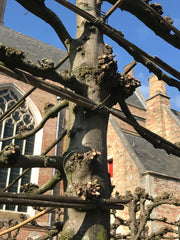Belgium Waffles, Beer, and Stubby Trees!
Posted on January 29, 2019 by Ed Coughlin
On a visit to Brussels, Belgium, where my son was studying abroad, I expected to see Waffles...
.
Check. And beer...
.
Check! Check! Check! What I didn't expect to see was anything horticulturally significant. No knock on Belgium, but it was winter and when one thinks of European gardens, the formal French and cottage gardens of England come to mind. What I saw on every street, steeple, and city center looked like an American version of "Crape Murder".
.
But these trees were manipulated, manicured, and artistically espaliered - similar to the practice of Bonsai - but on full grown Willows, Oaks, and Ash.
.
Turns out the Belgium practice of Pollarding was borrowed from the French. It's a technique when young trees and shrubs are cut to the main stem or trunk to no less than 6', ultimately controlling the height of the plants.
.
This is different from coppicing, because the trees and shrubs are not cut to near ground level. This practice of coppicing works wonderful on Eucalyptus trees where new foliage production is a top priority.
.
But Pollarding has other benefits besides controlling a trees' eventual size. They “can look weird,” wrote Landscape Designer Clive West in The Guardian. But, like him, I too am fascinated by their stunted and manipulated forms.
.
The technique also improves wind resistance, reduces invasive roots on city streets, and can increase the lifespan of the tree.
.
Again, not an art form for everyone, but I'm a big fan of the aesthetics and benefits brought to Belgium's beloved trees!
Next blog post: Martinique's most peculiar private garden - Jardin de Balata!
Posted in
← Previous


















